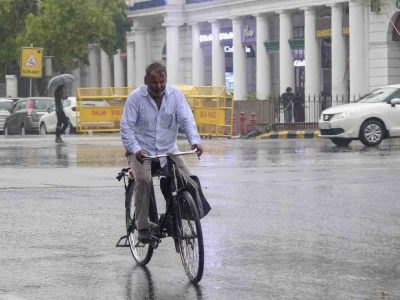Indian jails are obviously no place for hope – yet this book tells us there are committed activists, especially among retired police officers, who are paving the way for a better future for prisoners.
It is surprising for the lay readers to learn from this book that the Supreme Court has applied its mind to the rights of prisoners and given various observations/directions from time to time. It is surprising because the most obvious fault in the system is that poor people accused of a crime are incarcerated as undertrials for years on end, including women with children under six years. If just this one anomaly had been fixed, one would have believed that there is a sincerity about reforming the criminal justice system. For if suspects who are unable to get bail were not imprisoned, the overcrowding, the distress and callous treatment by jail staff would be a thing of the past.
But the past, the present and the future of the criminal justice system seem to be blurred into one unchanging monstrosity. Those who gain enough from the system – lawyers – become the richest professionals in India while the poor lived in sub-human conditions in jails that care nothing for human rights.
Anyway, this is what the SC believes are justiciable rights enforceable by courts:
- Right to human dignity, integrity of body and protection against torture or cruel, degrading or inhuman treatment
- Right to basic needs such as accommodation, food, clothing, bedding, sanitation and hygiene, healthcare, physical exercise and entertainment
- Right to access to law and speedy trial
- Right to communication with the outside world and contact with family members and legal counsel
For good measure, the apex court has added that prisoners have the right to reform and rehabilitation for re-integration in society as law-abiding citizens capable of making an honest living. Cleverly, this is described as an important obligation of the state with no binding force.
The above information is provided in the write-up by Chaman Lal, one of the 10 essays curated by Sanjoy Hazarika and Madhurika Dhanuka. Chaman Lal retired as an IPS officer and then served as Special Rapporteur on a pro-bono basis in the National Human Rights Commissions for nearly eleven years on matters relating to jails, among other issues. Predictably, none of the four rights outlined by the SC is properly enforced, nor do prisoners even know what they are, as he describes in detail. Well, the public already knows that. Regarding rehabilitation and re-integration of ex-convicts into society, one has never even heard of any NGOs or government departments engaged in this challenging task.
So, why is the word ‘hope’ used in the title of the book? Obviously, prisoners have no hope that somebody will improve the conditions in which they suffer and live, it is only those who handle them who hope for a better system being put in place. The editors say, “For those who engage with the prison system, hope often manifests in their activities and goals. A determination to improve conditions for prisoners, make an opaque system more transparent and accountable and ensure the practical realization of prisoners’ rights is what pushes many of us to carry on.” However, these pious intentions do not have any deadline attached to them, so they will probably meet the fate of accused persons, who wait for tareeq pe tareeq (hearing date after hearing date) until hope dies a natural death.
Another essayist Deepan Kumar Sarkar, an advocate at the High Court of Calcutta, writes quite poetically, “Prison attacks the soul, it attacks the heart, the thoughts, the will, the inclinations of the prisoner.” He summarises the philosophy of prisons in a cogent form:
In the early days, the idea of punishment was retributive or deterrent, but the twentieth and twenty-first centuries have seen an overwhelming push to recognize ‘reformation of the so-called criminal’ as a predominant goal of punishment. The increasing awareness of human rights and strict adherence to rule of law, irrespective of status, have contributed to this development. While keeping the offender outside the confines of society, the idea was to adopt proactive measures and provide an environment inside jails so that the offender emerges reformed and rehabilitated, ready to live harmoniously in society. Hence, the term ‘correctional home’ as opposed to jail.
In another essay, Sugandha Shankar and Sabika Abbas talk about the difficulties of research. One of the points they make is poignant: prisoners are only willing to respond to questions if they feel such interaction only in the hope (that word again) of gaining some advantage or tangible benefit in their personal case. Among their findings is one that pinpoints how, on the ground, everything that can go wrong does. “For instance, in one of the prisons, a child who looked much younger than 18 was admitted to prison because his age was mentioned as 19 years on the warrant. Neither the prison official reviewing the warrant raised a query nor the police escort seemed to care who had brought the child to prison.”
The plight of prison staff is also pitiable. They have to deal with piles of files amid inadequate infrastructure. “With little family time and almost no social life, burnout is bound to befall the officers. To overcome this, we often see convicts pitching in to do office work.” The researchers also learnt that a group of inmates was transferred to another prison as punishment for talking to them.
One problem area, as elaborated by S Ramakrishnan, ex-IPS and founder-director of the Regional Institute of Correctional Administration (RICA), Kolkata, is that there is gross neglect of training of prison administrators. Training jobs are not considered important and heads of training institutes are often unfit and incapable or are given charge as an additional duty. There is little acknowledgement that working in a prison is “a deeply stressful and demanding profession.” Thus both the trainers and trainees are hardly invested in the process.
Deviating from the main subject, there are two essays – ‘Voices from Detention’ by Amrita Paul and ‘Life in Detention Centres’ by Sangeeta Barooah Pisharoty – which are out of sync with the main theme. The first is about Rohingyas and the second is about Assam’s detention centres for those deemed foreigners. In such a slim volume (just 180 pages), the plight of Indian prisoners could not be adequately explored, it would require much more elaboration for this to be a serious addiction to the existing literature. Also, one finds it surprising that Kiran Bedi, who successfully reformed Delhi’s notorious jail, does not have any place among essayists for such a volume. It may be because she is on the other side of the ideological divide.
In the last chapter, which is probably the most enlightening, KR Raja writes about the educational status of children whose parents are imprisoned in the southern districts of Tamil Nadu. Moved by the plight of a convicted father of three sons, the Madras High Court had constituted eight committees to study every central prison and special prison for women “to identify the vulnerabilities of the children of persons in prison and find out measures to be undertaken for these young citizens.” What they found are obviously a lot of damning facts and statistics. In most cases, the education, health and general well-being of a child are badly damaged when a parent is imprisoned. The primary solution offered by the writer is better coordination among existing institutions like the Tamil Nadu State Legal Services Authority, the District Child Protection Unit, the Chief Education Officer of the School Education Department, NGOs and private educational institutions.
However, the biggest source of hope for India’s vast incarcerated population can only be empathy: empathy for those who may have committed a criminal act but are still entitled to basic human rights and the end of a cruel system developed by the British which is embedded in the laws that independent India has not struck off or replaced.
Hope Behind Bars: Notes from Indian Prisons, Ed by Sanjoy Hazarika & Madhurima Dhanuka, Macmillan, Pages 183
For more stories that cover the ongoings of Delhi NCR, follow us on:
Instagram: https://www.instagram.com/thepatriot_in/
Twitter: https://twitter.com/thePatriot_in
Facebook: https://www.facebook.com/Thepatriotnewsindia





